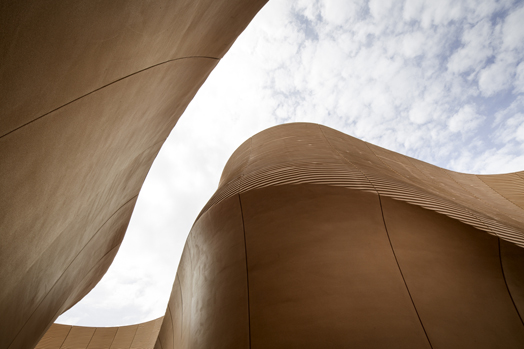Compiled by Team IAnD;
Information courtesy Foster+Partners
Photography: Filippo Poli;
courtesy Foster+Partners
Bringing the
planning principles of the traditional desert city to Milan, the United Arab
Emirates pavilion opened at the 2015 Milan Expo; the pavilion’s interior of
self-shaded streets evoking the experience of UAE’s ancient communities, while
demonstrating the natural energy efficiency of their compact urban form.
Foster +
Partners designed pavilion for United Arab Emirates occupies a large site close
to the centre of the Expo and is accessed via its main circulation axis, the decumanus.
From here, visitors are drawn into the mouth of a canyon-like space, defined by
two undulating 12-metre-high walls.
Influenced by
ancient planning principles, the paths through the pavilion are suggestive of
the narrow pedestrian streets and courtyards of the ancient desert city – and
its contemporary reinterpretation in the sustainable Masdar City masterplan in
Abu Dhabi, also designed by Foster + Partners.
.jpg) |
| . |
The walls
continue throughout the 140 metre site in a series of parallel waves, unifying
the visitor spaces within a dynamic formal language designed to express the
ridges and texture of sand dunes. To convey a distinctive sense of place, the
texture of the walls derives from a scan taken in the desert. The GRC
(Glassfibre Reinforced Concrete) panels are supported by a steel frame, which
can be easily demounted and reconstructed for the pavilion’s eventual
relocation in the UAE.
The
state-of-the-art auditorium is contained within a drum at the heart of the site.
A ramp leads gently upwards from the entrance towards the auditorium, and
augmented reality devices help to bring the story of the Emirates to life. After
the screening, visitors follow a path through further interactive displays and
digital talks, including a special exhibit celebrating Dubai as host city for
the 2020 Expo. At the end of the exhibition trail visitors reach a green oasis.
The landscaping around the pavilion and in the open public areas is designed to
evoke the terrain and flora of the UAE.
The design
follows the principles of LEED with a combination of passive and active
techniques. Most significantly, the building is designed to be recycled and
rebuilt in the UAE after the Expo.
As Lord Norman
Foster says, “Our challenge has been to design for two climates – to create a
naturally cool, comfortable space for visitors in Milan, while considering the
pavilion’s ultimate reconstruction in the Emirates, where there is a need to
provide shade from the intense sun. The design reflects our investigations into
the form of ancient cities and our appreciation for the desert landscape. It
also maximises the opportunities presented by the elongated site – the dramatic
canyon-like entrance welcomes people inside, and the channels between the high
walls provide intuitive circulation, naturally leading visitors to the
auditorium, exhibition and courtyard spaces.”

.jpg)
.jpg)

.jpg)
No comments :
Post a Comment